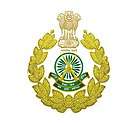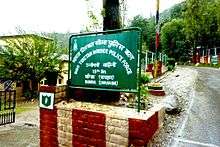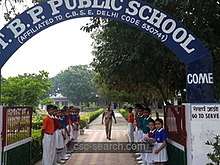Indo-Tibetan Border Police
| Indo-Tibetan Border Police | |
|---|---|
 Emblem of the Indo-Tibetan Border Police | |
| Common name | Indo-Tibetan Border Police Force |
| Abbreviation | ITBPF |
| Motto |
Shaurya – Dridhata – Karm Nishtha Valour – Steadfastness and Commitment |
| Agency overview | |
| Formed | 24 October, 1962 |
| Employees | 89,432 active personnel[1] |
| Annual budget | ₹5,521.67 crore (US$770 million) (2018-19 est.)[2] |
| Jurisdictional structure | |
| Federal agency | IN |
| Operations jurisdiction | IN |
| Governing body | Ministry of Home Affairs (India) |
| Constituting instrument |
|
| General nature | • Federal law enforcement |
| Headquarters | New Delhi, India |
|
| |
| Minister responsible |
|
| Agency executive |
|
| Parent agency | Central Armed Police Forces |
| Facilities | |
| Boats | 30 |
| Planes | 2 Helicopters |
| Website | |

The Indo-Tibetan Border Police (ITBP) is one of the five Central Armed Police Forces of India, raised on 24 October 1962, under the CRPF Act, in the wake of the Sino-Indian War of 1962. The ITBP was intended for deployment along India's border with China's Tibet Autonomous Region.
In September 1996, the Parliament of India enacted the "Indo-Tibetan Border Police Force Act, 1992" to "provide for the constitution and regulation" of the ITBP "for ensuring the security of the borders of India and for matters connected therewith".[4][5] The first head of the ITBP, designated Inspector General, was Balbir Singh, a police officer previously belonging to the Intelligence Bureau. The ITBP, which started with 4 battalions, has since restructuring in 1978 has undergone expansion to a force of 56 battalions as of 2017 with a sanctioned strength of 89,432.[6]
The ITBP is trained in Civil Medical Camp, disaster management, and nuclear, biological and chemical disasters. ITBP personnel have been deployed abroad in UN peacekeeping missions in Bosnia and Herzegovina, Kosovo, Sierra Leone, Haiti, Western Sahara, Sudan, Afghanistan and elsewhere. Two battalions of ITBP are deputed to National Disaster Response Force.
Command Control superstructure
ITBP, for the first two decades since its raising in 1962, till 1983, was headed by Inspector Generals of Police (IGs), all drawn from the IPS. In this period (1963–83), IGs had stable tenures, for instance B Chatterjee, IG, was head of the force from 02-06-1964 to 31-08-1974, and R N Sheopory, as IG, was head from 03-09-1974 to 22-12-1980. In 1983, the Indira Gandhi led Congress Government, upgraded ITBP head to Director General (DG). Since then, there has exponentially expansion of higher ranks, accompanied by volatility in the tenures of the head of ITBP. Instead of one IG as in 1983, ITBP now has 16 DG/IGs, and over 40 DIGs. The average tenure of DGs is about a year plus, and in some cases barely a few weeks, for instance B.B. Nandy, IPS, was DG (10-01-1997 to 03-04-1997), for just 28 weeks. Going by the trend of short tenures of DGs, it would appear that the Government is not overly concerned about command control, or in maintaining command continuity in the ITBP.[7] The post of DG was again upgraded by the Manmohan Singh led UPA Government in 2008.[8]
| Item | DG | IGs | DIGs | Remarks |
|---|---|---|---|---|
| Hqs | 1 | 7 | 13 | - |
| Frontier hqs | - | 7 | - | - |
| Sector hqs | - | - | 15 | - |
| Training | - | 1 | 12 | - |
| Total[7] | 1 | 15 | 40 | - |
Roles
ITBP is a multi-dimensional force which primarily has 5 functions:
- Vigil on the northern borders, detection and prevention of border violations, and promotion of the sense of security among the local populace.
- Check illegal immigration and trans-border smuggling
- Provide security to sensitive installations and threatened VIPs
- Restore and preserve order in any area in the event of disturbance
- to maintain the peace
Presently, battalions of ITBP are deployed on border guard duties from Karakoram Pass in Ladakh to Diphu La in Arunachal Pradesh, covering 3488 km of the India-China border. Manned border posts are at altitudes as high as 21,000 feet (6,400 m) in the western, middle & eastern sector of the border. ITBP is a mountain trained force and most of the officers & men are professionally trained mountaineers and skiers. The force is under an expansion plan in order to provide relief to its troops from constant deployment in high altitude areas under dynamic and professional leadership of Subhash Goswami, IPS.
- The border posts manned by ITBP are exposed to high velocity storms, snow blizzards, avalanches, and landslides, besides the hazards of high altitude and extreme cold, where temperature dips up to minus 40-degree Celsius. ITBP conducts Long Range and Short Range patrols to keep an effective vigil on inaccessible and unmanned areas on the border.
- The ITBP has recently taken on a disaster management role. Being the first responder for natural Disaster in Himalayas, ITBP was the first to establish 06 (now 08) Regional Response Centres in Himachal Pradesh, Uttarakhand and Northeast India and carried out numerous rescue and relief operations in various disaster situations, which took place in our areas of responsibility as well as other parts of the country. ITBP has already trained 1032 personnel in Disaster Management including 98 personnel in Radiological and Chemical and Biological emergencies.
- ITBP has established a National Centre for Training in Search, Rescue & Disaster response at Bhanu, Haryana which is imparting training to personnel of ITBP and other Paramilitary / State Police Forces. There is also a training centre for the Dogs at Basic Training centre situated at Bhanu. The centre is known as NICD.
- ITBP Commando units provide security to the Embassy and consulates of India in Afghanistan. Besides this two Companies of the ITBP are providing security in Afghanistan.
- One company of ITBP is deployed in United Nation Mission in Congo since November, 2005. A National Centre for UNCIVPOL training has been set up at ITBP Camp, Tigri, Khanpur, Delhi for providing systematic training to Indian Police Officers for deployment in UN Mission.
- ITBP is also providing security to the pilgrims during Annual Kailash Mansarovar Yatra from 1981. ITBP provides communication, security and medical cover to the yatries from Gunji to Lipulekh Pass and back to Gunji in co-ordination with MEA and Kumaon Mandal Vikas Nigam.
ITBP's major training centre is located at Mussoorie, in Uttarakhand. The Training Academy has been established in 1976, and imparts training to Officers, Subordinate officers, and promotional course. Specialised training programmes in rock craft, explosives handling etc. are also conducted here.Ace mountaineer and Padma Shri awardee, Harbhajan Singh, IG heads this institution. Keeping in view the evolving security scenario of the country, ITBP has established a Counter Insurgency and Jungle Warfare School (CIJW) at an altitude of 6000 feet in the heart of extremely tough Himalayan mountains, at Mahidanda in Uttarkashi district, under dynamic vision of the then DG of the Force Vikram Srivasatava, IPS. He provided top rated leadership to the force. The CIJW school provides state of the art training to ITBP's men and officers to enable them to take on the 21st century's security challenges in the form of anti Naxal Operations. Jungle warfare, handling of explosives, rock craft, survival in adverse conditions, unarmed combat, and guerrilla warfare are some of the subjects trained here.
The training regime, formulated under close supervision of Rajiv Mehta, IPS and executed on ground by Sanjeev Raina, DIG is extremely demanding both mentally and physically, needing special preparation. The presence of the force along the Indo China border, maintains vigil along the extremely difficult high altitude border area. The troops of the force keeps a sharp eye on any violation of the border, trans border smuggling, and affords a sense of security to the remotely located isolated settlements. The altitude where the troops are deployed range up to 18800 feet, and the temperature plummets to minus 30 degrees during winter with snow fall of more than ten feet.
The force is synonymous with adventure and dare-devilry and has undertaken numerous mountaineering expeditions. Its skiers have been national champions, who have competed winter Olympics. Its river rafters have created international history in rafting through the turbulent white waters of the mighty Brahmaputra, the Indus and the Ganges. The Force has created a milestone by becoming the first Central Para Military Force to grab up the Best Marching Contingent Trophy in the Republic Day parades in 1998, 1999, 2000 and 2011. It broke new ground in 1998 when it sent the first ever police tableau of the country to participate in the Republic Day Parade. ITBP is in the forefront of movement for the preservation of Himalayan environment and ecology. ITBP has taken up in a big way the task of greening the Himalayan regions especially in Inner Himalayas. Being the only human presence in areas close to China border, it has taken on itself the task of maintaining the delicate balance of flora and fauna.
ITBP being deployed in mountains has developed the expertise in rescue & relief operations in mountains, which entail different specialised skills of very high standard. It is always first in extending rescue & relief in case of natural calamity. ITBP conducts a large number of civic action programmes in remote border and terrorist affected areas to provide free and expert medical, health and hygiene care to the civilian population in remote villages.
ITBP Academy has been given the status of "Centre of Excellence" by the Government of India and now is on the path of modernisation of its training infra- structure. As of June 2004, the Academy has trained 3,785 GOs, 7,776 SOs and 27,476 Other Ranks from ITBP and CPOs/ State Police Forces.
Training centres
ITBP training centres develop amongst the trainees the qualities of: professional skills, esprit de corps and leadership. They are taught the values of integrity, impartiality and respect for all castes, creeds and religions. Maintaining the highest tradition of supreme sacrifice in the service of motherland the Himveers are also taught to function effectively while always keeping in mind human rights and the codes of war which always guide their conduct.
The Basic Training Centre at Bhanu, ITBP Academy at Mussourie, and the Mountaineering & Skiing Institute at Auli run the training programmes and conduct indoor and outdoor training activities, in pursuance of this mission.
The motto of the ITBP, Shaurya, dridata, karm nishtha (Valour, determination, devotion to duty) has always inspired its men in accepting challenges to bring glory to the nation and honour to the force. In the course of active duties, the force has earned a number of Civil and Service honours, and decorations like Padma Shree – 2, Shaurya Chakra – 1, Sena Medal – 1, President's Police Medal for Gallantry – 3, Police Medal for Gallantry – 44, President's Police Medal for Distinguished Service – 63, Police Medal for Meritorious Service – 292 and the Prime Minister's Life Saving Medal – 54.
ITBP has undergone a massive expansion plan to provide much needed relief to its troops who remain deployed in the tough high altitude terrain for most part of their service. 13 units were raised in the year 2006–07, followed by another 7 units the following year.
ITBP is building full fledge recreation and Training centre in Belgaum at Halbhavi, Belgaum provides the best climate for recreation and ITBP will relocate the personal and will have large family bases in Belgaum for its soldiers after high altitude stressful.
Education and Stress Counselling Services in ITBP
ITBP is the only Central Armed Police Force in India, which has combatised stress counsellors in its Field units, Formations Including the Ranks - Deputy Commandants ESC, Assistant Commandant-ESC, Inspector-ESC, Sub Inspector-ESC and Head Constable-ESC. These uniformed stress counsellors also play a major role in improving education for ITBP wards and the local children near ITBP Units. There are 21 ITBP Public Schools across the country run by ESC personnel of ITBPolice Force.[9]

ITBP Schools are located at remote areas like Arunachal Pradesh, Assam, Leh and Sonipat, Dwarka Delhi.
Equipment
- Pistol Auto 9mm 1A 9mmx19 mm
- Heckler & Koch MP5 A3 9mmx19 mm SMG
- AKM
- INSAS 5.56mmx45 mm Assault Rifle
- FN FAL self-loading rifle ( Indian origin, has been phased out 90%, with INSAS)
- INSAS LMG
- Bren LMG
- FN MAG MMG
- Carl Gustav 84 mm recoilless rifles
- AGS-30 Automatic Grenade Launcher
- 81 mm Mortar
- 51mm Mortar
Fatalities
- Assistant Commandant Ashok Kumar Rana was killed in 1998 at Chirwar, in the state of Jammu and Kashmir, in an encounter with Kashmiri insurgents.
- Deputy Commandant Joy Lal, was killed in a land mine blast.
- Inspector Raj Kumar was killed in 1997 in an encounter with Kashmiri insurgents at Wangam in the state of Jammu and Kashmir, and was posthumously decorated.
- Constable Suresh Kumar was killed in December 1994 in an encounter with Kashmiri insurgents in the state of Jammu and Kashmir, and was posthumously decorated.
- Constable Kishan Ram killed in March 1994 in an encounter with insurgents in District Anantnag in the state of Jammu and Kashmir, and was posthumously decorated.
- Three members of the ITBP were also killed in an attempt to climb Mount Everest during a severe storm in 1996.
- Ct Ajay Pathania and Roop Singh were killed when a suicide bomber attacked the Indian Embassy in Kabul, Afghanistan on 7 July 2008. Both the officers have been honoured with Kirti Chakra on 15 August 2008.
- Six ITBP personnel were killed during rescue operations in flood hit Uttarakhand when the Mi-17V5 helicopter of IAF crashed due to bad weather.
See also
References
- ↑ "Archived copy" (PDF). Archived from the original (PDF) on 8 August 2017. Retrieved 12 August 2017.
- ↑ "Archived copy" (PDF). Archived (PDF) from the original on 4 February 2018. Retrieved 3 February 2018.
- ↑ "Archived copy". Archived from the original on 29 January 2016. Retrieved 26 January 2016.
- ↑ "THE INDO-TIBETAN BORDER POLICE FORCE ACT, 1992 ACT No. 35 OF 1992" (PDF). Government of India. Archived from the original (PDF) on 29 October 2014. Retrieved 29 September 2014.
- ↑ "HISTORY AND ROLE OF ITBP". ITBP. ITBP. Archived from the original on 15 April 2015. Retrieved 29 September 2014.
- ↑ "MHA Annual Report 2016-2017" (PDF). Archived from the original (PDF) on 8 August 2017.
- 1 2 MHA (2016). "official website of Indo-Tibetan Border Police Force, MHA, GOI". MHA. Archived from the original on 29 January 2016. Retrieved 26 January 2016.
- ↑ Department of Personnel & Training (DOPT). "INDIAN POLICE SERVICE (PAY) RULES, 2007" (PDF). Government Of India Ministry of Personnel, Public Grievances & ... Department of Personnel & Training (DOPT). Archived from the original (PDF) on 8 March 2014. Retrieved 26 May 2015.
- ↑ "Archived copy". Archived from the original on 27 September 2017. Retrieved 27 September 2017.
- ↑ ITBP Assistant Commandant GD LDCE Result Archived 9 October 2014 at the Wayback Machine. UGCTET. Retrieved 9 October 2014.
External links
| Wikimedia Commons has media related to Indo-Tibetan Border Police. |
